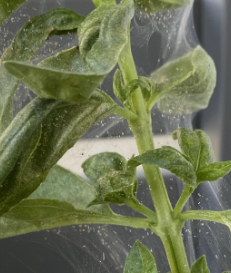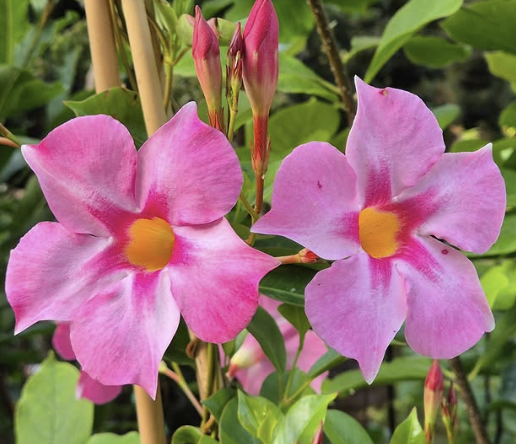Complete Guide to Brazilian Jasmine Plant Care: Tips for a Thriving Flowering Vine
If you’re looking to add a touch of the tropics to your garden or home, the Brazilian jasmine plant (also known as Mandevilla sanderi) is a fantastic choice.
With its trumpet-shaped blooms and sweet fragrance, this flowering vine is sure to brighten up any space.
Whether you’re growing it as a potted plant indoors or as an outdoor vine, Brazilian jasmine is relatively easy to care for if you follow a few key guidelines.
In this guide, I’ll share everything I’ve learned about Brazilian jasmine care, including lighting, watering, temperature, humidity, and more, to ensure your plant stays healthy and thrives!
What Is Brazilian Jasmine?
The Brazilian jasmine plant, often called Mandevilla sanderi, is a type of tropical vine native to South America, particularly areas like Rio de Janeiro. Known for its stunning pink jasmine or white flowers, this plant blooms abundantly from spring to late summer, making it a showstopper in both outdoor gardens and as an indoor plant. It’s a part of the genus Jasminum, though it is different from other true jasmine species like Jasminum sambac.
Size: How Big Will My Brazilian Jasmine Grow?
Brazilian jasmine is a flowering vine, which means it can grow quite large if allowed. It can reach up to 10 feet or more in length when grown outdoors, especially in warm climates with plenty of sunlight. When kept indoors in a potted plant, it tends to be more compact but still benefits from the ability to climb or trail, depending on the pot size and support.
Light: Best Lighting for Brazilian Jasmine
Brazilian jasmine loves bright light, but it does best in indirect light. If you’re growing it indoors, placing your plant near a south-facing window is usually the best way to ensure it gets plenty of light without being exposed to the harsh direct sunlight that can scorch its delicate leaves. In the summer, it can tolerate full sun outdoors, but you’ll want to protect it from the intense midday heat in hotter regions.
For outdoor gardens, make sure the plant is placed in a spot with plenty of partial shade during the hottest part of the day, especially if you’re in a very sunny location like Rio de Janeiro. Bright light will encourage the plant to bloom, while low light will result in weaker growth and fewer flowers.
Water: How Much Water Does Brazilian Jasmine Need?
One of the most common issues with Brazilian jasmine is root rot, which happens when the plant is overwatered. To prevent this, always check the soil moisture before watering. It’s best to water your Brazilian jasmine thoroughly, but allow the top inch or two of soil to dry out between waterings. During the growing season (early spring through late summer), the plant will need more frequent watering to support new growth and the blooming process.
In the winter months, when the plant is dormant, you should reduce watering to prevent excess moisture from causing root issues. Also, make sure your plant is in a pot with good drainage to avoid water from sitting at the bottom of the pot, which can lead to root rot.
Temperature: Ideal Temperature for Brazilian Jasmine
Since Brazilian jasmine is a tropical plant, it thrives in warm temperatures. The ideal temperature range is between 65°F and 75°F (18°C to 24°C). It doesn’t like cooler temperatures, so if you live in an area with cold winters, it’s best to bring it inside before the first frost. Even a slight chill can stress the plant and cause it to stop blooming or drop leaves.
If you’re growing it outdoors, make sure to protect it from cooler temperatures and danger of frost during the winter months. Indoors, it can thrive as a potted plant in warm temperatures year-round.
Humidity: Keeping Your Brazilian Jasmine Happy
Brazilian jasmine loves high humidity, which mimics its natural tropical environment. If you notice leaf drop or yellowing leaves, it could be due to dry air. To raise humidity, you can place your plant on a humidity tray with a tray of pebbles and water, or use a humidifier to keep the air around your plant moist. It’s important to keep your plant in a spot that maintains humid conditions—especially if you live in a dry area during the winter.
Soil: What Type of Soil Does Brazilian Jasmine Prefer?
The key to a thriving Brazilian jasmine is well-draining soil. The roots need to breathe and shouldn’t sit in overly soggy conditions. You can use a potting mix formulated for tropical plants, or create your own mix with equal parts of peat moss, perlite, and fresh soil for optimal drainage. This ensures that the soil retains some moisture but allows excess water to escape easily.
If your plant is in a potted plant, make sure the pot has good drainage holes to allow any excess water to flow out, preventing root rot.
Fertiliser: Feeding Your Brazilian Jasmine
For healthy growth and more blooms, Brazilian jasmine benefits from regular feeding. I recommend using a balanced liquid fertilizer once a month during the growing season. This will help encourage new growth and promote flowering. During the winter months, you can stop fertilizing since the plant is in a more dormant state and doesn’t need as much food.
Be sure to dilute the fertilizer to avoid overfeeding, which can cause leaf burn or hinder the plant’s growth.
Potting: Choosing the Right Pot for Your Plant
If you’re growing Brazilian jasmine indoors, make sure the pot is large enough to accommodate the root system, but not too large. A pot that’s too big can lead to waterlogging, while one that’s too small may hinder root development. Choose a pot with good drainage holes at the bottom, and add a layer of rocks or gravel to the bottom to further aid in drainage.
If your plant has outgrown its pot, it’s a good idea to repot it into a slightly larger one during early spring, which is the best time for transplanting.
Pruning: Keeping Your Brazilian Jasmine Tidy
Pruning Brazilian jasmine is important for maintaining its shape and encouraging more blooms. You can prune back the stems in early spring to remove any dead or damaged growth and to help the plant branch out. Pruning also helps control the size of the plant, especially if you want to keep it more compact as a potted plant.
Propagation: How to Grow More Brazilian Jasmine
If you want to grow more Brazilian jasmine, propagation is easy through stem cuttings. Simply cut a healthy stem below a leaf node, and place it in a glass of water or a container with well-draining soil. After a few weeks, the cutting will form roots, and you can plant it in its own pot or outdoor garden. This is a great way to share your plant with others or multiply your collection.
Pests: Common Pests to Watch For

Like many tropical plants, Brazilian jasmine can be susceptible to pests like spider mites. These tiny bugs can cause yellowing leaves and leaf drop. To prevent or get rid of them, wipe the leaves with rubbing alcohol or use insecticidal soap. Keeping your plant in high humidity can also help deter pests since they prefer dry conditions.
Diseases: How to Prevent Common Diseases
Brazilian jasmine is fairly resistant to diseases, but it can still fall victim to fungal diseases if it’s kept too moist or in poor air circulation. To prevent issues like root rot, always use well-draining soils and water the plant properly. If you notice any signs of disease, remove affected parts immediately and treat the plant with an appropriate fungicide.
Common Issues: Troubleshooting Brazilian Jasmine Care
- Yellowing Leaves: This could be due to overwatering or poor drainage. Be sure to allow the top inch of soil to dry out before watering again.
- Leaf Drop: Often a sign of stress, it could be from changes in temperature, humidity, or lighting.
- No Flowers: If your Brazilian jasmine isn’t blooming, it could be getting too much direct sunlight or not enough light in general. Make sure it gets enough bright, indirect light.
Conclusion: Enjoy Your Brazilian Jasmine!
Caring for a Brazilian jasmine plant can be very rewarding. With the right care—plenty of bright light, high humidity, regular watering, and good soil—you’ll have a plant that rewards you with vibrant pink jasmine or white flowers. Keep an eye on common issues like spider mites and root rot, and your plant will thrive year-round. Whether you grow it in a pot indoors or in your outdoor garden, Brazilian jasmine adds beauty and fragrance to any space!

